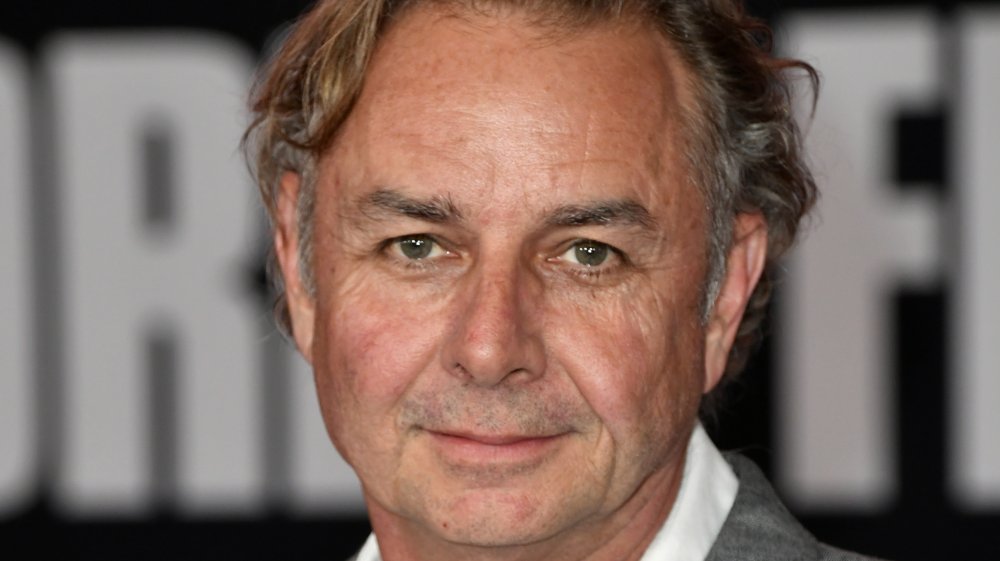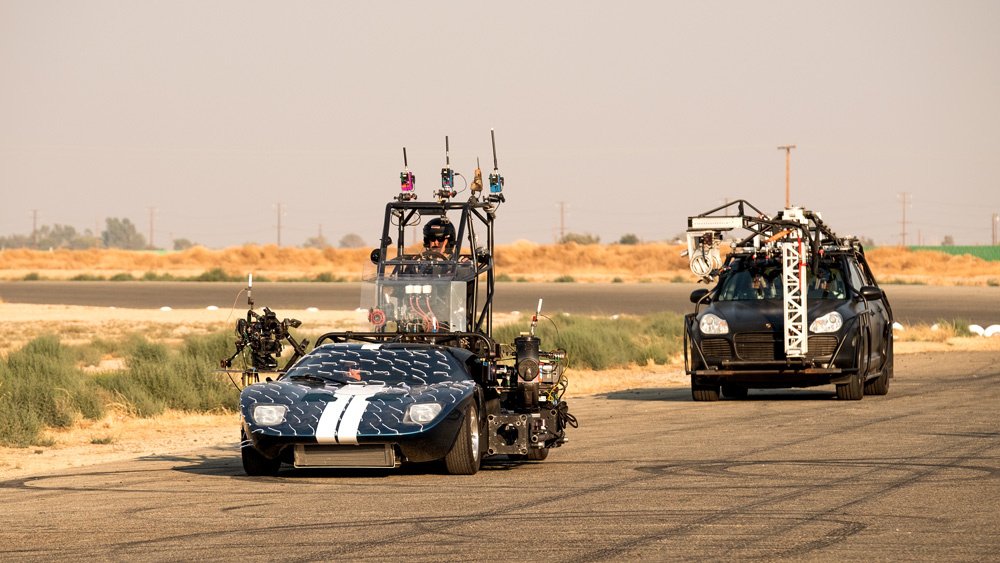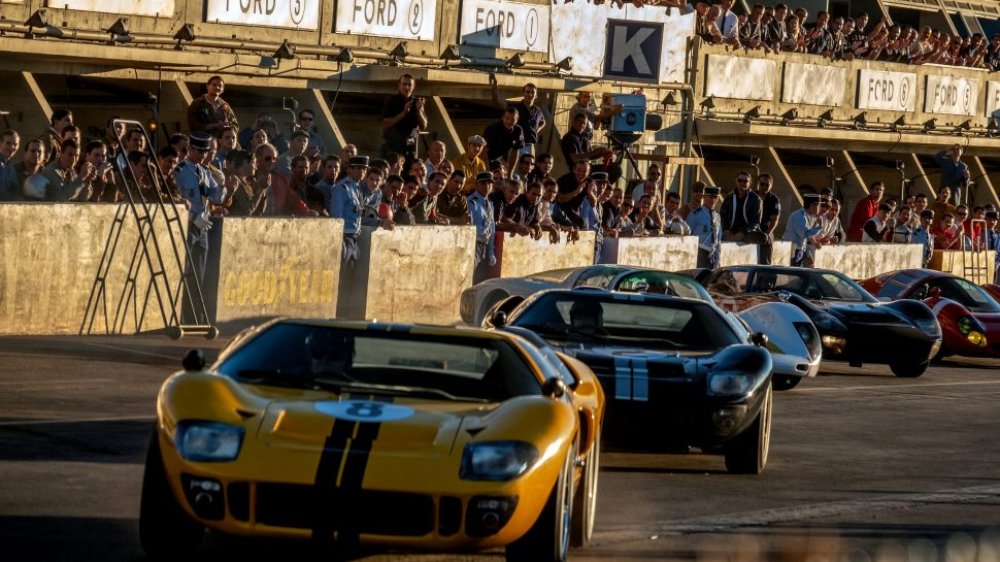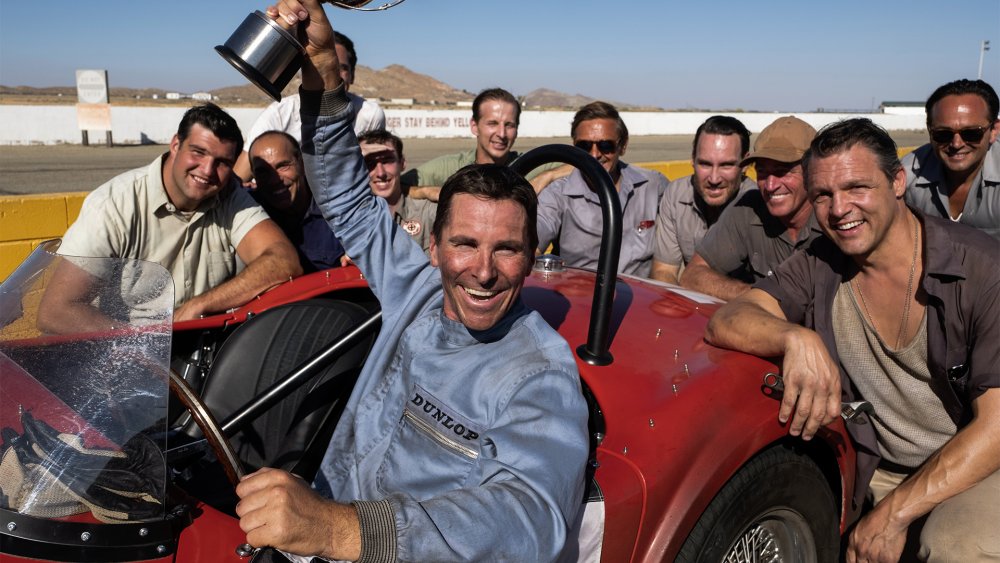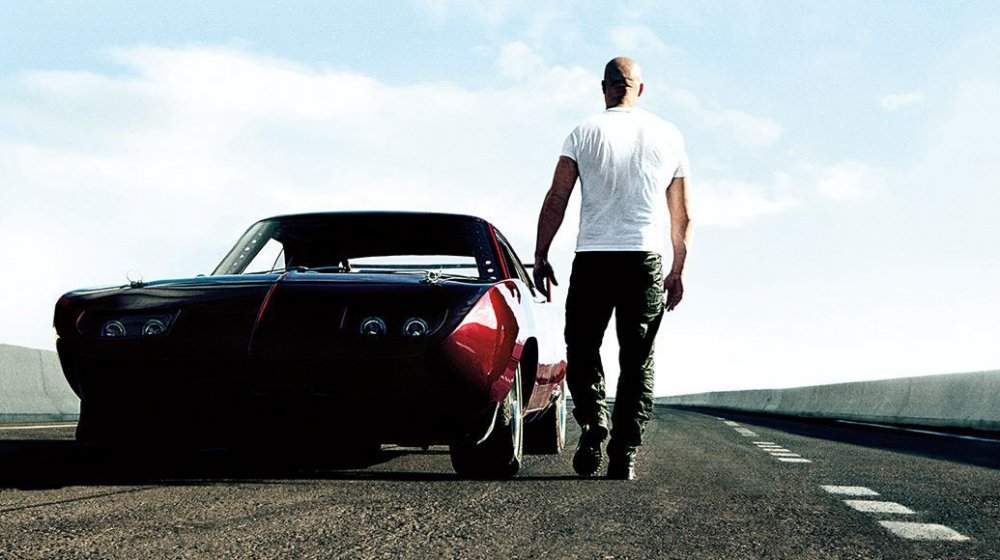Stunt Coordinator Robert Nagle Dishes On Ford V Ferrari And Fast & Furious - Exclusive Interview
If you've seen a movie with a major race scene, chances are you're familiar with Robert Nagle's work. While Nagle began his career as a racer, he's been one of Hollywood's go-to stunt drivers for the better part of 20 years, lending his talents to everything from Talladega Nights to John Wick to multiple Fast & Furious movies.
But Nagle isn't just a force to be reckoned with behind the wheel. He also won a Technical Achievement Oscar for inventing the Biscuit Jr. rig, which gives directors unparalleled freedom while shooting driving scenes, and has served as stunt coordinator on car-heavy movies like Baby Driver and Academy Award nominee Ford v Ferrari.
Nagle sat down with Looper and told us about his work on Ford v Ferrari and the Fast & Furious franchise, as well as what it takes to be a stunt driver in a major Hollywood action flick. Spoiler alert: as you might expect, it's not a job for the faint of heart.
From the race track to the silver screen
You started as a racer and moved into stunt work later. Why make that transition?
Well, the short, funny answer is that the money's going the wrong direction when you're racing. You can make a million dollars racing, but you need to start with $10. For me, as I got further up the ladder in the racing world, it just became more evident to me that it was more and more about the money that you could bring to the table. It kind of took away from why I chose to race. Because going down the back straightaway at 180 miles an hour and you're trying to think about where the next check is coming from to cover the expenses for the team, it just takes away from the passion of the sport.
But during that time, I met guys working in the film industry that I was racing with and it sounded kind of interesting. Eventually they wound up hiring me to come drive some race cars for a race movie, and I really enjoyed it. As I applied myself more and more into it, the creative process really drew me in. Writing new storylines and coming up with these ideas, getting them on film and getting the director's vision on film I find very satisfying.
How does driving a car for a stunt differ than driving in a race? Because in one you're trying to crash, and in the other you're trying not to crash.
Well, for racing versus crashing, it comes down to car control because the crashes may seem random at times, but they're not, they're very specific and very choreographed, because unless you get it on camera, it's all pointless. Things need to happen at a specific point in time. And there are some guys that just don't transition well from the race world into crashing cars, because as you said as a race driver the point is to not wreck.
But just having that skillset, the driving skillset, and applying it to a stunt driver works very well. And a lot of the guys I hire have a pretty solid race background, because I know I can put them in any car. The one main factor is the car, not them. Their skillset is far superior than most cars out there.
Over your career, you've worked as both a stunt coordinator and a stunt driver. What's the difference?
So, as the stunt coordinator, typically I'm tasked with designing and choreographing all the stunts, whether it be car stunts, fights, gun fights, all of that. Depending on the film and my involvement with the director — the two most prominent would be Baby Driver and Ford v Ferrari – I'm kind of given the latitude to design all the action and then present it to the director and he'd sign off on it.
On Ford v Ferrari, for the most part, he loved everything we did. And my personal approach as a coordinator, I typically try and write a story to fit that action, to describe the action and try and fit that into the narrative of the film so it all kind of flows together. As a stunt driver, I'm just the guy there waiting for direction from the stunt coordinator as to what to do and then perform that action as needed.
When you write that story, do you do it in script format?
It's not necessarily a script format. So, let's say for Ford v Ferrari, the three races, I just wrote a storyline from Ken Miles' perspective, since that's who we were focused on. So, what's going on around him, describing the race at any given moment so you can read through it. It's sort of a roadmap for the race, if you will. At any given moment, you know exactly what's going on. You should be aware what piece of action is happening and what corner the racers are turning, so on and so forth. And from there we can storyboard it and/or have the previsualization guys put it into an animated previs.
History in the re-making
Unlike Fast & Furious and Baby Driver, Ford v Ferrari based on a real event. It's not fantasy. Did that present any unique challenges for you as stunt coordinator?
Not really. I prefer it because we're grounded in reality and not in this hyper-reality universe. One of the things, I guess the challenging part was to... There were these key historical points specifically for the Le Mans race that we wanted to stay true to, and just putting those into the story. And then on top of that trying to make it a little more exciting without it being Fast and Furious. So, adding some of the crashes in and whatnot, and some of the interaction with the cars.
Do you have any specific examples of the stuff you added?
So, the biggest one we had was the big wreck that happens near the beginning of the race just past the Dunlop bridge where the car's tumbling, cartwheeling next to Ken Miles' car. And oddly enough, that was from a real racing crash. Our second unit director, Darrin Prescott, a number of years ago was invited to this celebrity race. I can't remember who the other driver was, but it was a Viper challenge series. He got to road race a Viper from Dodge at Road America. And he called me up, he's like, "Help, I don't belong here."
He just didn't have that much racing experience. But he's actually very skilled in a car. I just said, you'll be fine, just listen to what they're telling you. During the race there was a car in front of him coming off of a high-speed corner. It was a right-hand corner and the car went a little bit wide and dropped the outside wheels into the grass and that turned the car sideways and shot it back across the track and it hit a concrete wall and then just started tumbling. And they were doing a hundred plus miles an hour. And as he went by this thing that's just disintegrating in front of him and next to him, he was pretty certain he just saw somebody die and it was all caught on camera. And the guy walked away.
He was like, hey, let's see, can we do something with this? So, we just figured out how to try and duplicate a crash that horrific and just really drive the point home of how dangerous this race is. And this was his first lap of many over the next 24 hours.
In Ford v Ferrari, are the drivers going at race speed?
Close to it. When we shot, there's a piece for the Mulsanne straight, we were doing it probably 180, 185 miles an hour. We're probably running 90% of what the cars were capable of.
Are they the same cars that were used historically?
No, they're just replicas.
How similar are they to the original cars?
From the exterior they're very similar. It's when you turn them upside down and start looking at everything, they're not that similar. But from the exterior point of view for what we're doing it works.
There's a company that supplied a handful of them called Superformance and they're actually licensed to make exact copies, what they call continuation copies of the GT40, and he had a few of those. And they were amazing cars because they had a proper 427 in it and all that. It was exact duplicate from that car. Quite a beast to drive.
Is there any shot or sequence or element of Ford v Ferrari that you're either particularly proud of or that epitomizes your work on the project?
I'm super proud of all the car work. They put together an amazing team, but I've got to tell you I'm really happy with how the fistfight came out, because I choreographed it with stunt doubles. And then once I started working with Christian [Bale] and Matt [Damon] to go through the choreography of the fight, it dawns on me and I look at them, I say, wait a minute here, I have Batman and Jason Bourne and we're about to do a fight.
And by the way, guys, you don't know how to fight. It was a really fun element to put together because it was so different than most anything else you see. And these guys had a ball with it because it wasn't this very strict choreography of hyper-reality like the Jason Bourne and Batman fighting the villains.
Teaching Batman how to drive
You worked with Christian Bale and taught him how to drive like a racer, is that correct?
Mm-hmm. What I did with him is we spent a week out at the Bob Bondurant school out in Arizona and I just shadowed the instructor. I asked for one instructor and shadowed him to guide the training the way I needed it to fit for the film.
But part of the reason I picked Bondurant is that it's a really good training facility, and Bob Bondurant was an icon from that era and was a big part of that GT40 program. My hope was that we would be able to at least meet Bob for a couple hours and Christian would be able to talk with them a little bit. What it turned into was us training from seven in the morning until two in the afternoon every day for a week and then spending the next four to five hours every day sitting down just talking to Bob Bondurant and talking about that era and talking about his experiences.
And then the bigger surprise was to find out that he was very close friends with Ken Miles. And so just the information that we were able to get from that, from Bob, that Christian was able to ask him was amazing. And it was just a really almost surreal experience to be able to sit down with this guy for that long and listen to his stories. It was phenomenal.
But to continue with the training part of it, the last day of the training we finished in open real race cars, they're called Formula Mazdas and these are proper race cars. And one of the tests that I do to see how well whomever I'm training, how well they stay focused is to see if I can distract them and what I call, they start paying more attention to my car then they are their own car and then mistakes start to happen. And I hounded him pretty hard until I was inches off his gearbox and trying to just fill his mirrors left and right and doing everything I could to distract him and he never bobbled once. He's hands down the best actor I've ever trained.
Did you do anything with Matt Damon? Because he doesn't drive much in the film.
Yeah. So yeah, two things. One, there wasn't much driving for him. And two, I know from his past, because I've worked with him on the Bourne series, he's had plenty of training and I knew he'd be fine for what we needed. And he was actually quite handy in the car for the shots that I needed him to drive. He did a phenomenal job.
Did Bale do any driving in the final film?
There are times, because of the training we did with him, I felt very comfortable putting Christian in the car. To have him come screaming into the pits and jump out of the car, or to jump into the car and drive out, merge into traffic that's going 100, 150 miles an hour. That's Christian, you can't fake that.
Just as dangerous as it looks
We live in an age where CGI can do a lot. What do you think the benefit is to sticking with live action for car stunts?
For me, my personal view of it is there is a world where the CGI and practical stunts work very well together. And that is where the practical stunt is the focus of your eye and the peripheral, you can start manipulating the peripheral with CG. And that works very well.
It's been my experience when the principal subject is CG, I notice the difference and it kind of takes you out of the story, because you walk away from there like something's odd there. You can't point to it, but you just know it's not quite right.
Do you do rehearsals before you shoot?
It depends. A lot of the time, yeah, we do. There's a lot going on so we do run through rehearsal so everybody knows what we're doing. But these are all pro drivers, so I can for the most part talk them through what we need to do. We'll shoot what I call shoots of rehearsal, we'll film it and then adjust accordingly.
What is the most dangerous stunt you've done on a Fast and Furious movie? Not necessarily the most impressive visually, but the most dangerous?
I just don't look at them that way. A lot of times there's so much going on with some of these, I can't point to one for you. But there are times when we've got multiple cars, we have what we call cannons, which is what we use to flip the car over at speed. So, we may have multiple cars with cannons going off and explosions, pyrotechnics going off around us. So, there's a whole lot going on and a whole lot that can go wrong very quickly.
If I had to point to one, one that was pretty hairball was the opening to Fast & Furious 6. The day I showed up to work, we were filming in the Canary Islands in Tenerife, and there was this road that they wanted me to go shoot that was deemed too dangerous for the general public to drive on. It was blocked off.
And so they throw me in this high-speed Subaru camera car, it's a WRX STI Subaru. And they asked me to chase Ben Collins and Mark Higgins. He was a rally car champion. So obviously two very top drivers that had been driving this road for the last week and I've got to run flat out, chase them down with this camera car through this road. It's got a thousand-foot drop off into the ocean with these little blocks that will probably slow you down just enough so you get a really good view of where you're about to crash.
But we did it in one take, but the disturbing part was afterwards I commented to the guys like, man, some really bad potholes on that road. And somebody says to me, well, you know those aren't potholes, what are you talking about? Those are divots from rocks, they've been falling off the cliff on the other side of you that's a thousand feet up. I'm like, oh, that's reassuring. So, there's things like that. There's stuff like that that's out of your control. That's more dangerous than anything.
